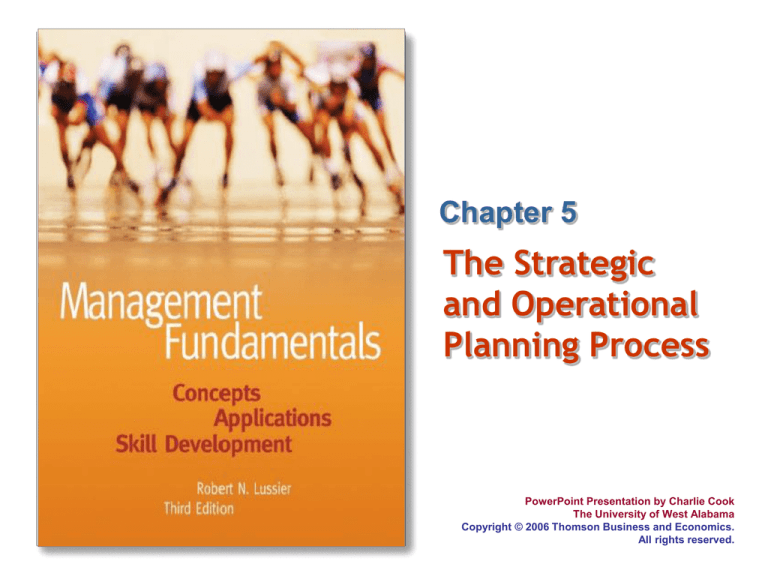
Chapter 5
The Strategic
and Operational
Planning Process
PowerPoint Presentation by Charlie Cook
The University of West Alabama
Copyright © 2006 Thomson Business and Economics.
All rights reserved.
Planning Dimensions
• Planning
– Determining what you want to accomplish and
developing approaches to achieving your
objectives.
• Planning Dimensions:
Exhibit 5–1
Copyright © 2006 Thomson Business and Economics. All rights reserved.
5–2
Strategic and Operational Planning
• Strategic Planning
– The process of developing a mission and longrange objectives and determining in advance
how they will be accomplished.
• Operational Planning
– The process of setting short-range objectives
and determining in advance how they will be
accomplished.
• Strategy
– A plan for pursuing the mission and achieving
objectives.
Copyright © 2006 Thomson Business and Economics. All rights reserved.
5–3
The Strategic Planning Process
Exhibit 5–2
Copyright © 2006 Thomson Business and Economics. All rights reserved.
5–4
Strategic and Operational Levels
Exhibit 5–3
Copyright © 2006 Thomson Business and Economics. All rights reserved.
5–5
Industry and Competitive Situation Analysis
• Situation Analysis
– Focuses on those features in a company’s
environment that most directly affect its options
and opportunities.
• Five Competitive Forces (Porter)
–
–
–
–
–
Rivalry among competing sellers in the industry
Threat of substitute products and services
Potential new entrants
Power of suppliers
Power of buyers
Copyright © 2006 Thomson Business and Economics. All rights reserved.
5–6
Porter’s 5 Forces Model
Starbucks’s Example
Exhibit 5–4
Copyright © 2006 Thomson Business and Economics. All rights reserved.
5–7
Parts of a Company Situation Analysis
1. Assessment of the present strategy based
on performance.
2. Strengths, Weaknesses, Opportunities,
and Threats (SWOT) analysis.
3. Assessment of competitive strength and
identification of competitive advantage.
4. Conclusions concerning competitive
position.
5. Determination of the strategic issues and
problems that need to be addressed
through the strategic planning process.
Exhibit 5–5
Copyright © 2006 Thomson Business and Economics. All rights reserved.
5–8
SWOT Analysis for
Starbucks Coffee
Exhibit 5–6
Copyright © 2006 Thomson Business and Economics. All rights reserved.
5–9
Competitive Advantage
• Core Competency
– A functional capability (strength) that the firm
does well and one that creates a competitive
advantage for the firm.
• Benchmarking
– The process of comparing an organization’s
products or services and processes with those
of other companies.
• Scanning the Environment
– Searching the external environment for
opportunities and threats.
Copyright © 2006 Thomson Business and Economics. All rights reserved.
5–10
Writing Effective Objectives
• Max E. Douglas’s model for writing effective
objectives:
– (1) the word to, followed by
– (2) an action verb,
– (3) a statement of the single, specific, and
measurable result to be achieved, and
– (4) a target date.
•
To achieve a 6% overall return on fourth quarter
sales.
• SMART Objectives
– Specific
– Measurable
– Achievable
– Realistic
– Time
Copyright © 2006 Thomson Business and Economics. All rights reserved.
5–11
Management by Objectives (MBO)
• Management by Objectives
Step 1. Set individual objectives and plans.
Step 2. Give feedback and evaluate performance.
Step 3. Reward according to performance.
• Sources of MBO Failures
– Lack of top management commitment and
follow-through on MBO.
– Employees’ negative beliefs about
management’s sincerity in its efforts to include
them in the decision-making process.
Copyright © 2006 Thomson Business and Economics. All rights reserved.
5–12
Corporate Grand and Growth Strategies
Exhibit 5–9
Copyright © 2006 Thomson Business and Economics. All rights reserved.
5–13
Portfolio Analysis: BCG Matrix
Exhibit 5–10
Copyright © 2006 Thomson Business and Economics. All rights reserved.
5–14
Competitive Strategies
• Differentiation
– Competing on the basis of features that
distinguish one firm’s products or services from
those of another.
• Cost Leadership
– The firm with the lowest total overall costs has a
competitive advantage in price-sensitive
markets.
• Focus
– Concentrating competitive efforts on a
particular market segment, product line, or
buyer group.
Copyright © 2006 Thomson Business and Economics. All rights reserved.
5–15
Strategies for Starbucks over the Product Life Cycle
Exhibit 5–13
Copyright © 2006 Thomson Business and Economics. All rights reserved.
5–16







